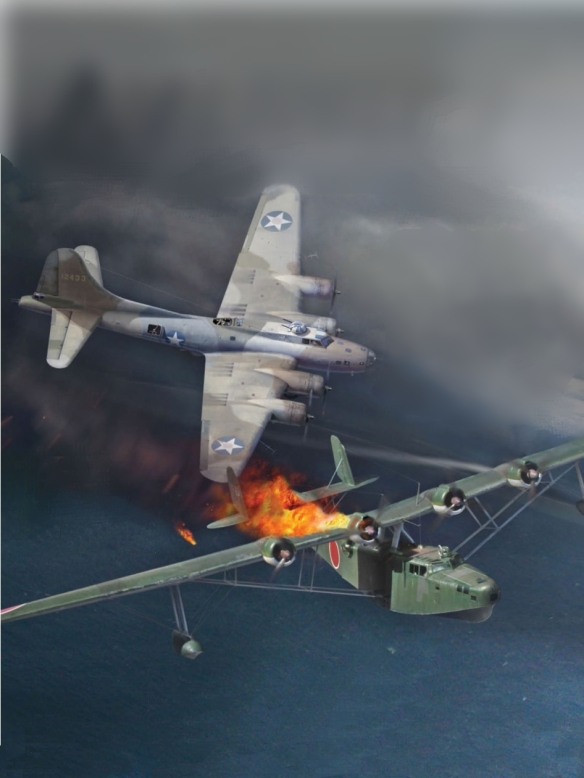
After surviving the Pearl Harbor attack, B-17E 41-2433 gets some payback against a Kawanishi H6K4 on October 23, 1942, in a Jack Fellows illustration.
One way or another, the 11th Group had by this time lost more than a dozen Flying Fortresses since moving to the New Hebrides. As a result, on October 18, Miss Fit joined the group’s 26th Squadron as a replacement. Five days later a routine anti-submarine patrol erupted into a ferocious duel when 433 encountered a four-engine Kawanishi H6K4 “Mavis” flying boat attacking a PBY-5A Catalina. War correspondent Ira Wolfert was aboard and he reported that the pilots, Lieutenants Edwin Loberg and Bernays Thurston, put the old bomber through a series of maneuvers that had it “shaking and rippling all over like a skirt in a gale.” During the running battle, navigator Lieutenant Robert Spitzer and bombardier Lieutenant Robert Mitchell were wounded. Finally, after 44 minutes of ear-shattering mayhem, the Mavis was down, floating in a pool of blazing fuel. Takeshi and his crew perished.
#
In his book Battle for the Solomons, war correspondent Ira Wolfert described what it was like aboard the B-17 Miss Fit (41-2433) when an anti-submarine mission turned into a duel with a four-engine H6K4 “Mavis” flying boat on October 23, 1942
“We dove straight down so rapidly that my knees buckled under me. The bottom turret was working. The nose bucked with its chugging, like the handle on an electric riveting machine. When we got on an even keel, I could stand up again and look out the window. We were in a squall.
Then we hurtled clear through the cloud and into blinding sunlight and there the Jap was, right alongside us, maybe fifty feet away. Every trigger on every gun on both planes was pressed at once and held. Thousands of bullets criss-crossed through the narrow spread of air. Our plane shuddered under the impact of bullet after bullet and teetered and buckled under the blasts of its own guns.
I could see a cannon firing at us, smoke blowing from its open mouth like frosted breath, and I could see our red tracer bullets pelt like darts into the Jap and ricochet off his armor and streak wailing straight up into the air.
The Jap made a tight turn and we followed suit. It was a delicate maneuver, the Jap having a mortal sting in his tail. To keep away from his tail and give our nose and side guns a chance to work him over, we had to turn inside him.
Then the sun blotted out and the whole wild scene was blotted out by an even wilder one as a cloudburst fell upon us like a mountain of loose rocks.
The Jap had dived into the cloudburst, either to lose us or to maneuver himself into a position to kill us.
We lost him five times in the fight, every time the Jap plunged into a cloud. we went racing after him and caught him just as he was breaking into the clear and hit him. The Jap kept very close to the water to make sure we wouldn’t come in under him. He has no guns there and we could tear his belly open with our top turret. So the fight was so low in the air there would be no escape.
A hit on the controls for either of us meant the end. This was kill or be killed all the way through, one of those arrangements known locally as ‘git’ or ‘git got.’ Twice we passed right over the Jap, so close I could see the jagged bullet-holes we had torn in him.
Then, at 1:01, exultantly Lieutenant Spitzer shouted, ‘He’s smoking! One of his motors is gone!’ Then Lieutenant Spitzer, who was still working his guns, shouted, ‘He’s down.’ There was an aching silence in the nose of the plane. Anyway, it seemed like silence. We had all been deafened by the noises of thousands of explosions.”